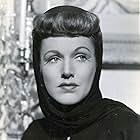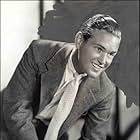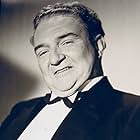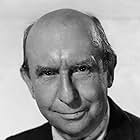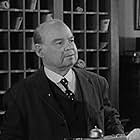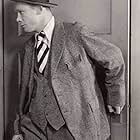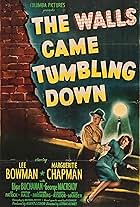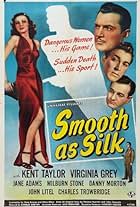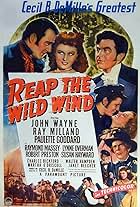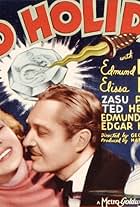Füge eine Handlung in deiner Sprache hinzuA district attorney tackles the "Wolf of New York" who is the mastermind behind a multitude of murders and robberies plaguing the city.A district attorney tackles the "Wolf of New York" who is the mastermind behind a multitude of murders and robberies plaguing the city.A district attorney tackles the "Wolf of New York" who is the mastermind behind a multitude of murders and robberies plaguing the city.
Hooper Atchley
- Detective
- (Nicht genannt)
Morgan Brown
- Juror
- (Nicht genannt)
Clyde Cook
- Jenkins
- (Nicht genannt)
Kernan Cripps
- Minor Role
- (Nicht genannt)
Charles K. French
- Juror
- (Nicht genannt)
Handlung
WUSSTEST DU SCHON:
- VerbindungenReferenced in Two Girls on Broadway (1940)
Ausgewählte Rezension
Wolf of New York (1940)
This is one of Republic Picture's better attempts at a Warner Bros. style crime film. And it's pretty good! This comes just a year or two before the first proto-noir films and it lacks some kind of existential loneliness and a good femme fatale, but in other ways noir lovers will see precursors at work.
Or just think of it as a crime flick, with a crooked lawyer, a dubious lawyer, a fumbling D.A., and a sweetheart of a girl who is involved with two of the three. Throw in a couple of sidekicks with character (and a couple more, like William Demarest, who overplay their parts) and you have a good, mix-em-up, not sure who to root for movie. It even has someone executed for a crime he didn't commit--a big deal that would be much bigger these days.
Republic was a small budget, B-movie studio that ventured into larger budget films over time. By 1940 they were well established and made some key films with major Hollywood players between contracts or loaned out. No one huge appears in this one, but a sense of good production values is visible, except the editing, I think, which is functional and even cursory, breaking the flow of a pretty sporty series of events.
So, with good social themes, a believable plot of theft and murder, and a rivalry between to top lawyers, this clicks along. The lead is a man who might interest those who like earlier films (from the silent era and the 1930s)--Edmund Lowe. He has a kind of John Barrymore persona (not to compare them further than that) and a stature and appearance that seem a little vintage for a 1940 production. But he's very good, and helps pull off some tricky scenes. The D.A. is the same guy who played a the D.A. in "Miracle on 42nd Street" and he's fine, too. The woman is played by Rose Hobart, who is really rather good, just not quite a leading lady cliché. (Joseph Cornell, the artist, was a big fan.)
See this? Well, yes, if you know you like this era of film even if it's not a great masterpiece. It's sharp enough, and with some good turns, and I think it's worth a look.
This is one of Republic Picture's better attempts at a Warner Bros. style crime film. And it's pretty good! This comes just a year or two before the first proto-noir films and it lacks some kind of existential loneliness and a good femme fatale, but in other ways noir lovers will see precursors at work.
Or just think of it as a crime flick, with a crooked lawyer, a dubious lawyer, a fumbling D.A., and a sweetheart of a girl who is involved with two of the three. Throw in a couple of sidekicks with character (and a couple more, like William Demarest, who overplay their parts) and you have a good, mix-em-up, not sure who to root for movie. It even has someone executed for a crime he didn't commit--a big deal that would be much bigger these days.
Republic was a small budget, B-movie studio that ventured into larger budget films over time. By 1940 they were well established and made some key films with major Hollywood players between contracts or loaned out. No one huge appears in this one, but a sense of good production values is visible, except the editing, I think, which is functional and even cursory, breaking the flow of a pretty sporty series of events.
So, with good social themes, a believable plot of theft and murder, and a rivalry between to top lawyers, this clicks along. The lead is a man who might interest those who like earlier films (from the silent era and the 1930s)--Edmund Lowe. He has a kind of John Barrymore persona (not to compare them further than that) and a stature and appearance that seem a little vintage for a 1940 production. But he's very good, and helps pull off some tricky scenes. The D.A. is the same guy who played a the D.A. in "Miracle on 42nd Street" and he's fine, too. The woman is played by Rose Hobart, who is really rather good, just not quite a leading lady cliché. (Joseph Cornell, the artist, was a big fan.)
See this? Well, yes, if you know you like this era of film even if it's not a great masterpiece. It's sharp enough, and with some good turns, and I think it's worth a look.
- secondtake
- 1. Juli 2013
- Permalink
Top-Auswahl
Melde dich zum Bewerten an und greife auf die Watchlist für personalisierte Empfehlungen zu.
Details
- Laufzeit1 Stunde 7 Minuten
- Farbe
- Seitenverhältnis
- 1.37 : 1
Zu dieser Seite beitragen
Bearbeitung vorschlagen oder fehlenden Inhalt hinzufügen

Oberste Lücke
By what name was Wolf of New York (1940) officially released in India in English?
Antwort


